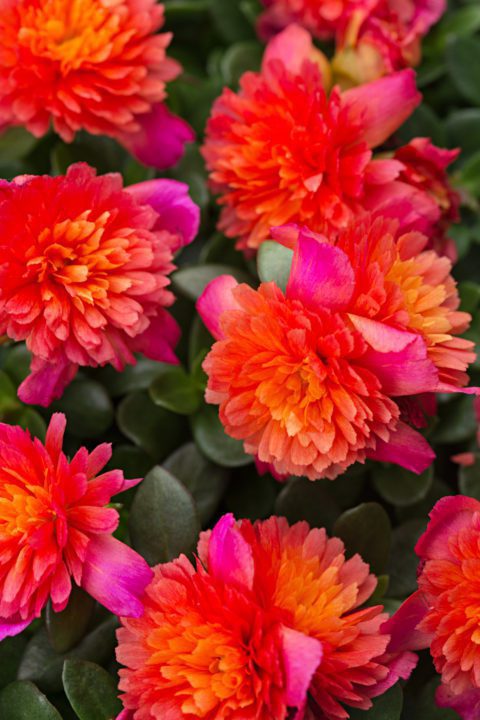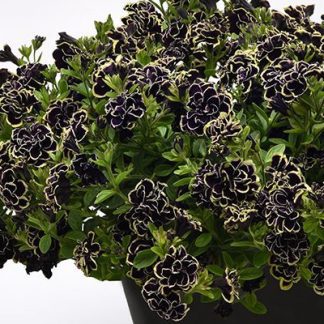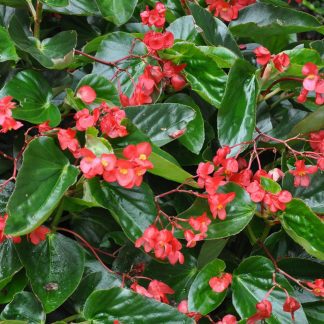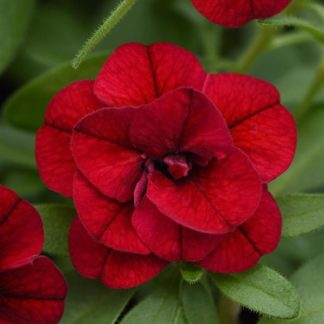Description
Meet the Star: SeaGlass Double Magenta Purslane
Imagine a plant that shines like seashells on warm sand. Picture petals so bold they almost glow against juicy green leaves. That is SeaGlass Double Magenta purslane. You may know purslane as a rugged groundcover or a pop of color in a hanging basket. Yet this SeaGlass variety takes the charm even further. Its blooms are fully doubled, forming layers of silky magenta swirls. They open each sunny morning and rest at night, like tiny beach umbrellas closing after a long, bright day.
SeaGlass Double Magenta belongs to Portulaca oleracea, a succulent family prized for toughness. In other words, it stores water in its leaves, so it laughs at heat and shrugs off dry spells. You and I can rely on it to sparkle when other flowers wilt. But most of all, it asks for very little. Give it sun, give it drainage, and then watch the color show begin.
Below, we will explore this plant from root to petal. We will talk about where it comes from, what makes it special, and how we can help it thrive. We will also share creative ways to use it in gardens and containers, simple care routines, quick troubleshooting tips, and even a few fun facts. By the end, you and I will feel ready to welcome SeaGlass Double Magenta into our own sunny spaces.
A Glimpse into Its Heritage
Purslane has a long, winding history. Wild forms grow on almost every continent, creeping along dunes, rock walls, and crossroads. Some cultures eat the leaves in salads. Others use the plant for herbal remedies. Over time, breeders noticed purse-shaped buds and dazzling colors rising in certain lines. They began selecting for bigger blooms, richer hues, and stronger branching. After more than many seasons of careful work, the SeaGlass series emerged.
SeaGlass varieties carry the name for a reason. Their flowers sparkle like polished bits of glass found along the shore. Double Magenta stands out with layers instead of a single row of petals. Each blossom may have 20 or more slender petals fanning out, almost like a miniature peony. Because of that, the blooms feel lush even though the plant itself stays neat and low.
Why Gardeners Fall in Love
1. Non-stop Color
SeaGlass Double Magenta blooms from late spring until the first hard frost. In regions with mild winters, it may bloom year-round. Instead of making us wait, it starts early and keeps going. The more sun it receives, the faster new buds appear.
2. Drought Defense
Succulent leaves hold moisture like tiny water bottles. Instead of wilting in summer heat, the plant simply sips from its own reserves. That means less watering for us and less worry during hot vacations.
3. Compact and Versatile
At about 6 to 8 inches tall and 12 to 14 inches wide, SeaGlass Double Magenta fits many spots. It trails gently over container edges, fills cracks between stones, and forms colorful rivers in raised beds.
4. Pollinator Friendly
Bees and butterflies adore the rich nectar hidden inside each double bloom. You and I gain a lively, buzzing garden while helping local pollinators find a steady meal.
5. Self-Cleaning
Unlike some annuals that need deadheading, this purslane tosses old petals on its own. New buds push upward without extra pruning. In other words, we get more beauty with less fuss.
Ideal Spots in the Garden
Full-Sun Beds
Line the front of a sunny flower bed with SeaGlass Double Magenta. The low growth forms a vivid border that frames taller plants like salvia or zinnia.
Rock Gardens and Slopes
Rocks and sandy soil drain fast, which purslane loves. Instead of fighting the slope, plant pockets of SeaGlass to hold soil and color the scene.
Containers and Window Boxes
Mix it with silver artemisia, chartreuse sweet potato vine, or upright grasses. The trailing stems soften edges, while the magenta blooms pop against foliage of any shade.
Hanging Baskets
Let stems spill over the rim, catching sunlight from every direction. Pair with white bacopa for a two-tone wave, or keep it solo for a bold magenta cascade.
Edging Walkways
Use SeaGlass to frame stepping-stone paths. The plant hugs the ground so it never blocks the walkway, yet it invites every passerby to pause and admire the blooms.
How to Plant SeaGlass Double Magenta
Soil Preparation
- Loose and sandy is best. If your soil feels heavy, mix in coarse sand or fine gravel.
- Aim for pH between 5.5 and 7.0. Purslane tolerates a wide range but prefers slightly acidic to neutral ground.
Light Requirements
- Six hours of direct sun is the minimum.
- More sun equals more flowers.
- Light shade in late afternoon is fine in zones with triple-digit heat.
Spacing
- Plant starters 10 to 12 inches apart.
- Allow room for side stems to spread and breathe.
Planting Steps
- Water seedlings well before planting.
- Dig a hole as deep as the root ball and twice as wide.
- Gently place the plant so the soil line matches ground level.
- Backfill, firm lightly, and water to settle roots.
Instead of covering roots with heavy mulch, use a thin layer of gravel. Gravel keeps crowns dry and reflects light onto the foliage.
Everyday Care Made Simple
Watering
During the first two weeks, water every other day so roots take hold. After that, let the top inch of soil dry before watering again. Deep soak once a week in moderate climates. Twice a week during extreme heat waves. Remember, overwatering hurts more than drought. Yellow, mushy leaves signal too much moisture.
Feeding
Feed lightly. Use a balanced, water-soluble fertilizer at one-quarter strength every four weeks. Too much nitrogen can push leaves over blooms. In containers, extra feeding may be needed because nutrients wash away faster.
Pruning
Pruning is optional. If stems grow too long, pinch tips to encourage side shoots. You can also shear the plant by one-third midsummer. New branches will fill in quickly.
Pest and Disease Watch
Purslane rarely suffers from pests. Still, keep an eye out for:
- Aphids – Rinse with a strong spray of water or use insecticidal soap.
- Spider Mites – Increase humidity or spray with neem oil.
- Root Rot – Avoid soggy soil and waterlogged pots.
Because leaves are thick and juicy, fungal spots seldom gain a foothold. Good air flow finishes the job.
Seasonal Care Guide
| Season | Task | Notes |
|---|---|---|
| Early Spring | Start seeds indoors 6–8 weeks before last frost | Keep soil warm (70°F) |
| Late Spring | Transplant seedlings or set out nursery plants | After danger of frost |
| Summer | Water deeply, feed lightly | Pinch if desired |
| Early Fall | Take cuttings for winter windowsill crop | Root in moist sand |
| Winter (Zones 9–11) | Trim lightly after bloom pause | Protect from heavy rain |
Propagation Pathways
Seeds
Collect dry seed pods when they turn brown. Sow on the surface of moist mix. Press seeds in but do not cover; light helps germination. Keep warm and bright. Sprouts appear in 7–10 days.
Cuttings
Snip 3-inch stem tips, remove lower leaves, and stick them in damp sand or perlite. Roots form in one week. Plant rooted cuttings into small pots for gifts or to bulk up displays.
Division
Older clumps may be split in early spring. Lift, pull apart gently, and replant sections. Each piece should have at least one growing tip.
Clever Design Ideas
Coastal-Vibe Patio Planter
- Center: Blue chalksticks (Senecio serpens)
- Middle Ring: SeaGlass Double Magenta purslane
- Edge: Golden creeping jenny (Lysimachia nummularia ‘Aurea’)
The cool blue, vivid magenta, and bright gold echo a seaside sunset.
Water-Wise Curb Strip
Blend SeaGlass Double Magenta with dwarf yarrow, sedums, and Mexican feather grass. This low-water mix turns a hot curb into a soft, colorful welcome mat.
Candy-Shop Basket
Pair the magenta blooms with Calibrachoa ‘Double Yellow’. Instead of competing, the two create a sweet sherbet duo that tempts every eye.
Troubleshooting Quick List
| Problem | Likely Cause | Simple Fix |
|---|---|---|
| No flowers | Too much shade | Move to sunny spot |
| Leaves turning brown at base | Overwatering or poor drainage | Reduce water, add gravel |
| Stems too leggy | Low light or crowded pot | Pinch tips, increase light |
| Buds drop before opening | Sudden cold snap | Cover at night or move containers |
Kid-Friendly Garden Activity
Invite children to “count the layers” on each blossom. Hand them a small magnifying glass. They will discover how many petals make up one double flower. After more than a few minutes, they may notice visiting bees. This simple game teaches observation and respect for tiny garden friends.
Culinary Note
While ornamental varieties are bred for beauty, all purslanes share edible ancestry. The leaves taste lemony and crisp. Still, only harvest from plants grown without chemicals and rinse well. If you and your family wish to sample, add a few leaves to a salad. In other words, the garden can feed both eyes and taste buds at once.
Fun Facts
- Purslane seeds can stay viable for up to 40 years in soil.
- Ancient Persians believed purslane brought good luck and cooled the body.
- NASA once studied purslane for space gardens because of its drought tolerance.
- SeaGlass blooms close at night, a sleep cycle called nyctinasty.
How We Can Help Pollinators with Purslane
By choosing SeaGlass Double Magenta, we offer a summer buffet packed with nectar. Bees easily land on flat petals. Butterflies sip without struggle. Instead of sterile beds filled only with foliage, we give living creatures a reason to visit. Add a small birdbath nearby, and the garden becomes an oasis for many wings.
Step-by-Step Care Summary
- Pick the Sunniest Spot – Six hours or more is best.
- Check Drainage – Sandy or gravelly soil keeps roots happy.
- Plant with Space – Twelve-inch gaps allow airflow.
- Water Wisely – Let soil dry, then soak deep.
- Feed Lightly – Monthly low-dose fertilizer keeps blooms coming.
- Watch and Enjoy – Remove weeds, pinch stray stems, welcome pollinators.
Growing SeaGlass Double Magenta Indoors
If you have a bright south-facing window, you can overwinter cuttings in small clay pots. Use a cactus mix, water sparingly, and keep room temperatures above 60°F. The plant may bloom less inside, but fresh stems will be ready for outdoor planting once spring returns.
Harvesting Seeds for Next Season
Wait until late summer. Brown seed capsules will appear where petals once shone. Gently pinch a pod over a white piece of paper. Tiny black seeds will sprinkle out like pepper. Store in a paper envelope in a cool, dry drawer. Mark the name and year. Instead of buying new packs, you can sow your own saved seeds next spring.
Companion Plants that Shine Beside Magenta
- Silver Dust Dusty Miller – Silky silver leaves make magenta pop.
- Lemon Coral Sedum – Chartreuse cushions echo the flower centers.
- Firecracker Cuphea – Upright orange spikes add height and warm contrast.
- Snowstorm Giant Snowflake Bacopa – White blooms create gentle balance.
Mix any two or three for a container that turns heads from porch to patio.
How to Keep It Blooming into Autumn
After more than three months of color, SeaGlass may slow down. To push a fresh flush:
- Trim back stems by one-third.
- Water deeply.
- Feed with a bloom-boost formula high in phosphorus.
- Return the pot to full sun.
Within two weeks, new buds will appear, carrying you through the crisp, bright days of fall.
Sustainable Notes
Because SeaGlass Double Magenta needs little water and no heavy spraying, it supports a greener garden. Fewer resources go in, less runoff flows out, and pollinators find a safe stop. In other words, choosing this plant is one step toward an eco-wise landscape.
In Review: Why We Cherish SeaGlass Double Magenta
- Dazzling double blooms paint the garden from spring to frost.
- Succulent leaves provide built-in drought armor.
- Low, trailing habit suits beds, baskets, and rocky nooks.
- Care is simple: sun, drainage, and occasional drinks.
- Bees and butterflies visit daily, adding motion and life.
When we plant SeaGlass Double Magenta, we invite a splash of bold joy that thrives with minimal fuss. Gardens feel brighter. Containers feel fuller. Our outdoor moments feel richer.




